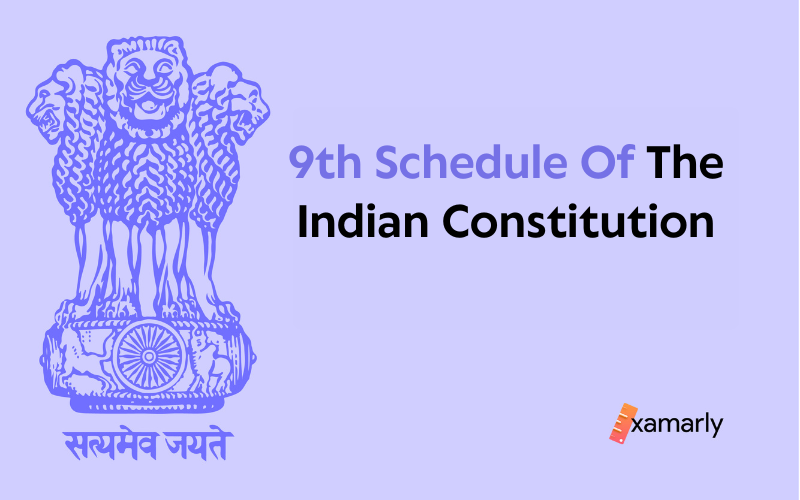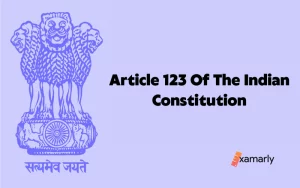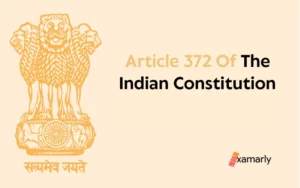The foremost amendment to the Indian Constitution briefly highlights and introduces the 9th schedule and Article 31B. It was passed in 1951. It was intended to pass new legislation. Such legislation would be crucial in making India a more equitable nation.
The government’s decision to divide zamindars into different categories to acquire their land was criticized by the judiciary sources in the case of Kameshwar Singh v. The State of Bihar, and it was a major setback with questions as the Court stated that doing so was a violation of Art. 14, which ensures equal protection of the law for all citizens, as such classification was discriminatory. As a result, the amendment was urgently needed. The 9th schedule of the Indian Constitution is discussed in detail in the article that follows.
- What Is A Judicial Review?
- What Is The 9th Schedule Of The Indian Constitution?
- Objectives Of The 9th Schedule
- Important Provisions
- Scope Of Judicial Review For Laws Placed Under The 9th Schedule
- Supreme Court Judgment Related To Ninth Schedule Of The Indian Constitution
- Impact Of The Judgment
- Conclusion
- FAQs
What Is A Judicial Review?
According to the democratic notion of judicial review, the Indian judiciary may invalidate-
- legislative and
- executive act
The legislative, executive, and judicial branches of the government all function in harmony with one another thanks to a technique of inspections and proportions. The judicial consideration in the Indian setting is described as follows.
- The United States of America’s constitution’s judicial review clause was adopted by the Indian constitution.
- Article 13 of the Constitution of India addresses judicial review.
- Judicial Review indicates the following-
- The constitution is the nation’s supreme law and all other laws are subordinate to it.
What Is The 9th Schedule Of The Indian Constitution?
- The 9th schedule was created by J. L. Nehru’s administration in independent Indian democracy. A list of federal and state laws that are unchallengeable in court can be found in the ninth schedule.
- These laws are exempt from judicial review and cannot be overturned because they violate the basic rights of the judiciary (even the Supreme Court).
- There are now 284 statutes listed in it.
- The Agricultural Land Ceiling Act, the Essential Commodities Act, the Land Acquisition Act, and others are a few of this legislation.
- Despite being exempt from judicial assessment, the Supreme Court judged in 2007 that even laws listed in the Ninth Schedule would be subject to judicial review if they violated the Constitution’s fundamental principles or its structure.
Objectives Of The 9th Schedule
- To put into effect several land issues and land reforms after Independence.
- The Zamindari system must be abolished. It is to put an end to feudalism and make room for socialism to take its place.
- To repeal legislation that may violate fundamental rights and act as barriers to reform.
- To protect the weakest members of society by keeping them up to date with the overall population.
- To carry out the constitutional duty of establishing an equal society. It is done by reducing the concentration of land in a few hands and sharing the land among farmers.
Important Provisions
- The Ninth Schedule was assembled by the contemporary Article 31B, which was passed by the government together with Article 31A to safeguard agrarian reform laws and eliminate the Zamindari system.
- Features of Article 31B protect particular laws or enactments, but Article 31A protects “classes” of laws.
- 13 additional statutes were added to the Schedule as a result of the First Amendment of the Constitution. The number of protected legislation rose to 284 with modifications. These modifications were in the years 1990, 1994, 1955, 1975, 1976, 1984, 1964, 1971, 1974, and 1999.
- Retrospective application of Article 31B means that if immense power laws are added to the Ninth Schedule after they have been ruled unconstitutional, they are regarded as having been there from the beginning and are therefore legitimate.
- The Supreme Court judgement has previously indicated that regulations beneath the Ninth Schedule would be a matter to review. It is when they disobeyed basic rights or the essential framework of the Constitution, even though the insertion of Article 31B forbids judicial review.
- The majority of the laws covered by the Schedule concern agriculture issues and land issues, although there are other topics on the list as well.
- A Tamil Nadu statute that guarantees 69% state-wide reservation is included in the Schedule.
Scope Of Judicial Review For Laws Placed Under The 9th Schedule
Prior to proceeding with any additional, it may be summarised as follows: the area of analyzing the legislation included in schedule 9 of the Indian Constitution is constrained. Behind the Kamleshwar case, the parliament presented the foremost amendment. It was for inserting article 31B and the 9th schedule to implement agricultural reforms. The clauses were counted. It was in order to shield the legislation introduced beneath them from judicial interference.
Next the foremost modification, Shankari Prasad was the significant landmark judgement. It was the issue in which the issue of immunity provided to parliament was conveyed before the court. It was questioned whether the insertion of the device under Article 31B, when read in conjunction with Schedule 9, was unconstitutional as it did not provide judicial pronouncements. It was argued that barring judicial review of such laws would violate Article 13 of the Constitution.
“There is a fairly clear delineation between ordinary law and constitutional law. Thus, as a result, the alterations made under Article 368 are not impacted by the application of article 13,” the Court said in rejecting the case. Additionally, underneath Article 368, the parliament has the power to amend fundamental rights as well; in such cases, judicial encroachment is prohibited.
However, it was later determined in the Golaknath lawsuit that the parliament lacked the authority. They lacked the authority to change the provisions on personal property as well as other fundamental rights. It was argued that barring judicial review of such laws would violate Article 13 of the Constitution.
The trial would be to notice if the relevant legislation has the prospect to contravene any of the articles that serve as the cornerstone of the whole Indian Constitution. Through the adoption of the fundamental design idea, this issue restrained the vast authority of the parliament and supported the judiciary. This point is viewed as saving Indian democracy as well.
However, when a similar case involving the 39th amendment of the Constitution by the parliament, which added some contentious rules underneath the ninth schedule, came before the court in Indira Gandhi v. Raj Narain, the court ruled that ordinary laws added to the ninth schedule cannot be matter to the primary system test and that only constitutional amendments made in accordance with Article 368 are subject to judicial consideration if they violate basic structure.
Supreme Court Judgment Related To Ninth Schedule Of The Indian Constitution
The Supreme Court of India held a historic decision on January 11, 2007. It states that all laws (even those under the Ninth Schedule of the Indian Constitution) would be subject to judicial consideration if they broke the fundamental form of the constitution. Yogesh Kumar Sabharwal, the Chief Justice of India, stated that such laws “ought to be overturned” if they “abridge or abrogate fundamental rights resulting in the breach of the essential structure of the constitution.”
According to the Supreme Court’s ruling, laws added to the Ninth Schedule after April 24, 1973, may be subject to legal challenge. It will be if they infringe upon fundamental liberties protected by Articles 19, 20, 14, and 21 of the Constitution.
Check out the linked articles to learn about other relevant articles from the table given below:
Impact Of The Judgment
The assessment mainly put an end to the debate surrounding the Ninth Schedule and was successful in blocking political attempts to exclude some delicate topics from judicial review for specific political purposes. The historic decision was successful in enhancing the democratic foundation of society. It was also for bringing unfair actions of abuse of the Constitution’s ninth schedule into the domain of righteousness.
Conclusion
In conclusion, the constitution’s creators created an effort to keep the area of judicial consideration (legislative powers) within boundaries, concerning the ninth schedule.
This is clear from the point that the core of the property right was such that it would have been open to numerous conflicts from the beginning. The mishandling of Article 31B and the ninth schedule, however, didn’t begin until the fourth subsequent amendments, when rare non-agrarian actions were left outside the purview of judicial review.
But finally, the Apex Court’s intervention from Shankari Prasad to Keshavananda Bharati ensured to put a curb on the legislative body’s powers by outlining the fundamental framework of the Constitution. The ninth schedule’s requirements should have been modified to permit judicial consideration when the parliament abolished the rule of the right to property by the 44th amendment. But since it didn’t, Article 31B and the ninth schedule persisted to function as a broad parliamentary inclusion clause for whatever measure the parliament saw appropriate. This left the 9th schedule of the Indian Constitution exposed to misuse and exploitation.
FAQs
In Which Year Was The 9th Schedule Added?
The Ninth Schedule of the Indian Constitution was added on 10th May 1951 to the constitution of India.
Who Introduced The 9th Schedule?
The Ninth Schedule was inserted into the Constitution of India. The Ninth Schedule received 13 new laws as a result of the first amendment. The Nehru Administration brought it into existence.
How Many Acts Are In The Ninth Schedule?
Since 1951, the 9th schedule of the Indian Constitution has been constantly expanded. It is expanded to accommodate the 284 acts that it does today. The 1951 foremost amendment to the constitution adds 13 new laws to the schedule. Six new acts were counted to the fourth legislative amendment, which was further altered. The 17th amendment counted 44 laws, while the 29th amendment added 20 laws altogether.
Can The 9th Schedule Be Challenged?
The Ninth Schedule Amendments made after April 24, 1973, are subject to dispute because they violate the Constitution’s fundamental principles and go beyond the legislative authority of the Parliament. To put it another way, the protection of Article 31-B only applies to those Acts that were included before April 24, 1973, so amendments made to Acts that have already been set in the Ninth Schedule are not automatically immune from legal challenges even behind their inclusion in the Ninth Schedule.






